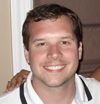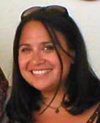|
|
|
| P R I N T E R - F R I E N D L Y F O R M A T | Return to Article |
D-Lib Magazine
September/October 2012
Volume 18, Number 9/10
AERI 2012 Digital Curation Pre-Conference
Alex H. Poole, Christopher A. Lee, and Angela P. Murillo
University of North Carolina at Chapel Hill
Point of contact for this article: Alex H. Poole, ahpoole@email.unc.edu
doi:10.1045/september2012-poole
Abstract
Organized under the auspices of the DigCCurr II project funded by the Institute of Museum and Library Services (IMLS), a digital curation pre-conference symposium was held on July 8, 2012 at the University of California-Los Angeles in association with the Archival Education Research Initiative's AERI 2012. Seven digital curation experts from six institutions led the day's sessions, which focused on digital curation education. The symposium discussed the importance of curriculum development, mentoring, seeking funding, research strategies, and collaboration across disciplines and institutions both nationally and internationally.
Overview
A Digital Curation Pre-Conference symposium was held on July 8, 2012 at the University of California-Los Angeles in association with the Building the Future of Archival Education and Research Initiative's Archival Education Research Institute (AERI 2012). The symposium was organized under the auspices of the DigCCurr II project, "Extending an International Digital Curation Curriculum to Doctoral Students and Practitioners" (2008-2012) and was led by seven digital curation experts from six institutions. Both the Initiative and DigCCurr II are funded by the Institute for Museum and Library Services (IMLS).
AERI 2012 brought together diverse students and faculty members from national and international institutions. The Digital Curation Pre-Conference's goals jibed with AERI's. In particular, both foregrounded mentoring and cohort-building at all stages of graduate and professional education; designing curricula; and developing stimulating research agendas. Focusing on the imperative of digital curation and open to all AERI 2012 attendees, the Pre-Conference drew fifty graduate students and faculty members.
DigCCurr II (IMLS #RE-05-08-0060-08) is preparing future faculty to teach and to perform research in digital curation. Digital curation, as Helen Tibbo noted in her introductory remarks, is part of "a very new world that has come on very quickly." The pre-conference focused on the key roles and responsibilities for educators of archival professionals; as Cal Lee and Helen Tibbo observe, "Professional education is a process that is never completed."1
Program Description
Session 1: The Context of Research and Teaching in Digital Curation
Cal Lee of the University of North Carolina at Chapel Hill began the program by tackling digital curation's role in research and teaching. Though the term "curation" was employed as early as the fourteenth century, the notion of "data curation" emerged only in the 1980s and that of "digital curation" only in the early 2000s. Despite the concept's youthful provenance, more than a dozen streams of activity cluster under its penumbra. Similarly, at least 50 organizations or associations, from the American Library Association to the Tape Head Interface Committee, relate their activities to digital curation. Collaborations remain crucial and should coalescence across disciplines, institutions, and other social boundaries. Lee addressed the competencies and knowledge requisite in undertaking digital curation tasks. He also discussed the place of archivists and other professionals in digital curation.
Session 2: Navigating Digital Curation Research Opportunities
The second session included presentations and break-out sessions and proceeded under the guidance of Christine Borgman of the University of California-Los Angeles, Ciaran Trace of the University of Texas-Austin, and Helen Tibbo (chairperson). It revolved around digital curation research, namely strategies for scoping, collaborating, publishing, and seeking funding. As digital curation activities can target any part of an object's lifecycle, researchers must circumscribe their work:
First, they must consider what skills, background, and expertise they have, and calibrate how much time they have available for research.
Second, researchers should determine what type of study or scholarly "niche" they prefer: broad or focused, short-term or long-term. Similarly, they should identify the most important research problems in their area, whether a new area or one already cultivated by scholars. Reading literature reviews, networking, and consulting experts can all prove useful. Perhaps most important, researchers must decide if they can impact their preferred area. Finally, they must calculate how much finding and support are available. Digital curation researchers should also exploit opportunities for collaboration. But as Tibbo noted, "Really good collaboration is hard." First and foremost, researchers must determine with whom to collaborate, considering disciplines, institutions, skills, expertise, and funders' influence. Collaborative work differs from individual work: collaborators must grapple with methodological issues, publishing challenges (e.g. formats, venues, turnaround time, and questions of attribution), and multiple Institutional Review Boards. Such conversations, moreover, must occur up front. Collaborators must determine who will serve as the Principal Investigator, for instance, or who owns the data the project produces. In this vein, Christine Borgman discussed two exemplary research sites: the Center for Embedded Networked Sensing (CENS) and the Sloan Digital Sky Survey (SDSS).
Third, digital curation professionals must publish. Researchers must consider optimal journals and conferences for their research but also remain attuned to the venues current at their home institution(s). They must choose a target audience, be it government, private, academic, Information and Library Science, archival, Information Technology, or information policy.
Fourth, digital curation researchers often must secure funding. Funding comes in all shapes and sizes, but as Ciaran Trace asserted, merely being eligible is not tantamount to being competitive. Researchers may start small with "low-hanging fruit" such as a summer research assignment and build from that base. Similarly, researchers may collaborate with another researcher more "seasoned," perhaps by serving as a Co-Principal Investigator. Researchers should also identify the person(s) at a given funding agency who can offer help and support. In addition to soliciting input at all stages from colleagues and mentors, digital curation researchers must harness all relevant resources, from attending workshops to consulting program officers, from monitoring newsletters and listservs to volunteering as grant reviewers. Above all, researchers should create solutions for specific communities.
Session 3: Digital Curation Pedagogy
The pre-conference's third session again included both presentations and breakout discussions. It focused on pedagogical strategies, specifically developing and implementing course materials, programs, and curricula, and on characterizing one's teaching to one's employers. Karen Gracy of Kent State University's School of Library and Information Science spoke about broad teaching strategies, Richard Pearce-Moses of Clayton State University described his institution's Archival Administration track, and Cal Lee shared his experiences with the Digital Acquisition Learning Lab (DALL) project — funded by the Andrew W. Mellon Foundation — at the University of North Carolina at Chapel Hill's School of Information and Library Science.
Gracy argued that teaching about access to digital technology represents the sine qua non of digital curation education. She offered educators five strategies for developing courses, programs, and curricula: start with learning objectives and then create modules, assignments, and assessments; collaborate, e.g. by sharing syllabi; develop case studies and examples from diverse contexts and environments; make digital curation transferable to multiple settings; and make digital curation "real" to students. Gracy also detailed the challenges inherent in online teaching, including the differences between teaching synchronously as opposed to asynchronously and the types of assignments that work best in such contexts. Finally, Gracy spoke about the difficulty of demonstrating the value of digital curation education to one's employers, especially given the time and resources necessary in implementing and sustaining such education. Thus she advocated for the creation of better formal guidelines for academic programs in service of developing new degrees and certificates in digital curation.
Building upon Gracy's observations but taking a case study approach, Richard Pearce-Moses spoke about Clayton State University's Archival Administration track in its program in Archival Studies. Differentiating between "hard" (technological) and "soft" (social) skills, Pearce-Moses outlined the track's three technological goals: fluency, competency, and practical experience. Additionally, he listed five desired technological outcomes: self-reliance, communication skills, the ability to experiment, identification of potential solutions to specific problems, and continuing self-education. To these ends, Pearce-Moses proposed a pedagogical method involving lectures, assignments such as step by step handouts or video demonstrations, peer support, and both virtual and face-to-face office hours. Technology-based assignments include simple programming exercises and practice with common tools such as Archivists' Toolkit and Curator's Workbench. Through these activities students become broadly familiar with digital contexts.
Like Pearce-Moses, the session's chairperson, Cal Lee, adopted a case study approach in outlining "Hands-On Digital Forensics Education for Information Professionals (Including Archivists)." Predicated upon applying digital forensics to the acquisition of digital materials, the Digital Acquisition Learning Lab (DALL) project included training, hardware, and software to support practical exercises in courses. Broad goals included the translation of industry models, techniques, and methods into forms salient to information professionals and the building of overall capacity by improving training, computer laboratory arrangements, and curricula. The DALL project provided useful lessons regarding digital curation education: showing the value of embedding tasks within the larger framework of electronic records courses, demonstrating the advantage of having extant data (i.e., disk images) to use, and revealing specific technical challenges related to data size and time involved in carrying out forensics tasks.
Session 4: Agenda-Setting for the Future
Rounding out the day's activities, Carolyn Hank of McGill University helped participants to craft individual six-month plans for their own digital curation education agendas. Key factors attendees weighed included time commitment, experience and expertise, and the merits of working as an individual versus working as part of a group.
Conclusion
The Pre-Conference segued smoothly into the week-long AERI 2012, held July 9 - 13, 2012, and underscored the connections between DigCCurr and AERI. Attendees integrated various themes in digital curation into the broader intellectual landscape of archival education and research. The symposium met its goal, and laid the groundwork for future dialogue and mentoring among students and faculty members at future AERIs and other venues.
Notes
1 Christopher Lee and Helen Tibbo, "Where is the Archivist in Digital Curation? Exploring the Possibilities Through a Matrix of Knowledge and Skills," Archivaria 72 (Fall 2011), 167.
About the Authors
 |
Alex H. Poole is a third-year doctoral student at the School of Information and Library Science at the University of North Carolina at Chapel Hill. A Fellow on the DigCCurr II Project: Extending an International Digital Curation Curriculum to Doctoral Students and Practitioners, he focuses on digital curation, the digital humanities, and all things archival. |
 |
Christopher A. Lee is Associate Professor at the School of Information and Library Science at the University of North Carolina, Chapel Hill. His primary area of research is the long-term curation of digital collections. He is particularly interested in the professionalization of this work and the diffusion of existing tools and methods into professional practice. Lee edited and provided several chapters to I, Digital: Personal Collections in the Digital Era. He is Principal Investigator of the BitCurator project, which is developing and disseminating open-source digital forensics tools for use by archivists and librarians. |
 |
Angela P. Murillo is a third year doctoral student in the School of Library and Information Science at the University of North Carolina at Chapel Hill. Her research areas include digital curation and preservation, scientific data management, reuse of data, and scientific metadata. She is the project manager and a doctoral fellow of the DigCCurr II Project: Extending an International Digital Curation Curriculum to Doctoral Students and Practitioners, University of North Carolina-Chapel Hill. |
|
|
|
| P R I N T E R - F R I E N D L Y F O R M A T | Return to Article |